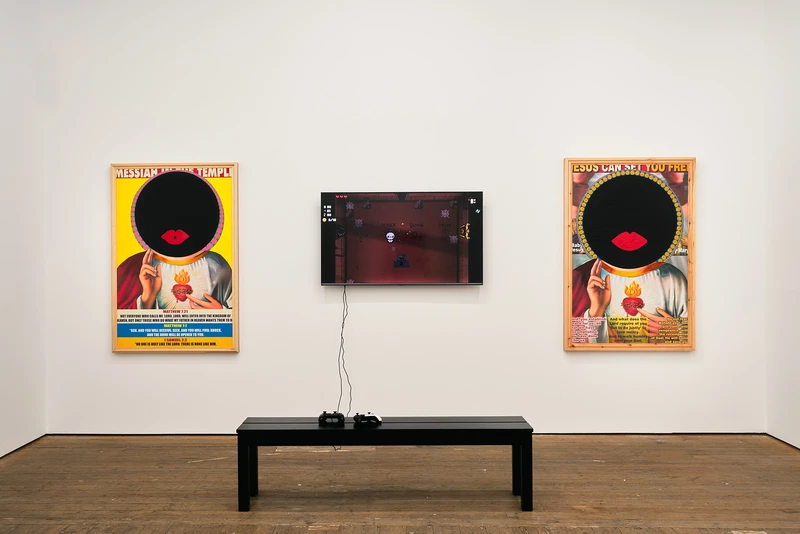Larry Achiampong: And I saw a new heaven
4 May-17 Jun 2023


Referencing the unlikely trinity of HBO TV, video games and Christianity, the title drawn from dialogues from the game-turned-series The Last of Us and ultimately from the Bible encapsulates the references for Larry Achiampong’s second solo show at Copperfield. From computer games to church the cast of faces represented there has almost always been white. The already problematic status quo that church is high culture and gaming is low or pop culture breaks down here when one references the other, but the exhibition brings real game play for visitors into direct dialogue with Achiampong’s collaged paintings.
“video games have had huge influence on my art work and the reality of their sophistication and cultural referencing is ignored by the rest of the creative sphere. It’s time for video games to take their place as context in the gallery while I work on my ultimate goal; a playable artwork. At its core gaming is storytelling, world building, fantasy, exploration and human culture in one”
What is missing still, trailing behind even film and TV, is minority representation in games. What scant references there have been to people of colour or the queer community for example have almost always been negative or derogatory with just one or two recent exceptions like Beyonetta. Why though when nearly half of game players in the US alone are people of colour? While the mechanics differ, this cause and effect of this uncomfortable fact can ultimately be connected to a similar peculiarity in religion.
Almost anywhere in the world touched by white missionary work, from the Philippines to Ghana, you can find congregations of colour surrounded by posters and imagery with an entirely white cast of God, Mary, Jesus, disciples and crew. The incongruity of a chalk white Jesus with his apparently middle eastern origins is hugely questionable, but in the context of countries that have been repressed by white western imperialism, the apparent perpetuation of these images by these congregations becomes even more unsettling. As a starting point for the works in the exhibition, Achiampong has selected a series of typical religious posters from Ghana to paint over. Their plethora of graphic and immediate imagery draws on a pastiche of dated advertising styles and, in turn, so does Achiampong’s response. While the Golliwog or minstrel show character is an uncomfortably recognisable icon of Britain and America's colonial past, the immediacy of this image when reduced here to an internet style avatar, belies its complex and often obscured history. Other more subtle painted edits and editions amplify the way in which these works question, disrupt and take ownership of these problematic legacies by obscuring parts of the posters. The frame on the face of each panel is custom made by hand by Larry in a nod to the idealised story of Christ as carpenter vs the realities faced by many undervalued manual work forces today. The framing style is comparable with the kind found in the humble places of worship Achiampong experienced as a child — grand in form but with no pretence of gilding or hiding the knots — in other words, strangely honest.
Nearby, games like Bayonetta 2, The Binding of Isaac, and Blasphemous give context to the works for visitors through play. The Binding of Isaac was made in darkly humorous response to the game developers Catholic and Baptist upbringing which Achiampong’s childhood shares, and is loosely based on the Bible story of the same name, but has as much to say about childhood as organised religion. In their aesthetics and sounds, and references to literature and history, Blasphemous and Bayonetta 2 relate to Christianity – specifically, the Catholicism with which the artist grew up – and explore the problematic aspects of religion and blind Faith. An uncanny dialogue thus arises between these games and the artworks, from their use of racialised imagery, to that of language: Biblical commands, lifted from Latin; teachings from Psalms demanding control of the self under the guise of support. It is a question of independently analysing the instruction given to us by a ‘higher power’, of considering the self in the broader context of accepted traditions and behaviours.
It is the intro sequence from 2014 blockbuster game Bioshock Infinite that welcomes visitors to the exhibition. While part fantasy, the game draws on some of humanities darkest moments, and gives context to the kind of processes that have led to historic whitewashing across culture. The game is set in the fictional city of Columbia, founded by self-proclaimed prophet Zachary Comstock, and funded by the American government as a floating world's fair within the ideology of American exceptionalism. Worshipped as a prophet, Comstock has transformed the city into a theocratic police state, with the Founding Fathers of the United States venerated as religious icons. Play makes it clear that institutional racism and elitism are widespread in the city, with minorities serving as a labour underclass on the verge of rebellion.
Sound familiar?